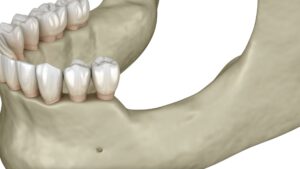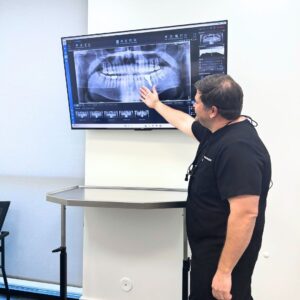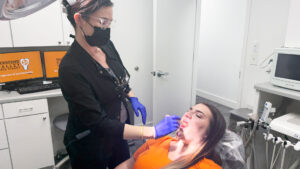If you’ve been told you have bone loss in your jaw, you might think dental implants are no longer an option for you. Maybe you’ve been dealing with missing teeth for months or years, or perhaps gum disease has affected your jawbone. You might be wondering if you’ve waited too long or if the damage is too severe for implants to work.
Here’s the good news: at Tennessee Valley Oral Surgery, we help patients with bone loss get dental implants every day. Having some bone loss doesn’t automatically mean you’re not a candidate for implants. In fact, with modern techniques like bone grafting, we can often rebuild the foundation your jaw needs to support strong, lasting dental implants.
We take care of you like family, and that means finding solutions that work for your unique situation. Let’s explore what bone loss means, how we assess your jawbone, and why you might still be an excellent candidate for dental implants.

Understanding Bone Loss in Your Jaw
When you lose a tooth, your jawbone doesn’t just stay the same. Within the first year after tooth loss, your jawbone can lose up to 25% of its width in that area. This happens because your jawbone needs the pressure and stimulation from tooth roots to stay strong and healthy.
Think of it like muscles – when you don’t use them, they get weaker over time. Your jawbone works the same way. Without tooth roots to stimulate it, the bone gradually shrinks away, a process called resorption.
Common Causes of Jawbone Loss
Several things can lead to bone loss in your jaw:
– Missing teeth – This is the most common cause, and it happens naturally over time
– Gum disease – Advanced gum disease can destroy the tissues and bone that support your teeth
– Trauma or injury – Accidents that damage your teeth and the surrounding bone
– Infections – Untreated infections can damage your bone tissue
– Certain medications – Some treatments can affect your bone density over time
The important thing to understand is that bone loss is a common issue, and it’s one we deal with successfully all the time.
How We Assess Your Jawbone
Before we can determine if you’re a candidate for dental implants, we need to get a clear picture of your jawbone’s current condition. This assessment is thorough but completely painless.
 Advanced Imaging Technology. We use state-of-the-art 3D imaging to see exactly what we’re working with. This technology gives us detailed pictures of your jawbone from every angle, showing us:
Advanced Imaging Technology. We use state-of-the-art 3D imaging to see exactly what we’re working with. This technology gives us detailed pictures of your jawbone from every angle, showing us:
– How much bone you currently have
– The quality and density of your existing bone
– The exact areas where bone loss has occurred
– The best locations for implant placement
– This detailed view helps us create a treatment plan that’s perfectly tailored to your mouth and situation.
 Measuring Bone Density and Volume. Not all bone loss is the same. Some people might have lost width but still have good height, while others might have the opposite situation. We measure both the amount of bone you have and how dense it is.
Measuring Bone Density and Volume. Not all bone loss is the same. Some people might have lost width but still have good height, while others might have the opposite situation. We measure both the amount of bone you have and how dense it is.
Dense, healthy bone provides excellent support for implants. Even if you don’t have a lot of bone, if what you have is good quality, we might be able to work with it directly.
 Looking at Your Overall Health. Your general health plays a role in how well dental implants will work for you. We’ll review your medical history and current medications with you to make sure implants are a safe choice. Conditions like diabetes or osteoporosis don’t automatically rule out implants, but they do help us plan your treatment more carefully.
Looking at Your Overall Health. Your general health plays a role in how well dental implants will work for you. We’ll review your medical history and current medications with you to make sure implants are a safe choice. Conditions like diabetes or osteoporosis don’t automatically rule out implants, but they do help us plan your treatment more carefully.
The Magic of Bone Grafting
Here’s where things get really exciting. Even if you have significant bone loss, bone grafting can often restore the foundation you need for successful dental implants.
What is Bone Grafting? Bone grafting is a procedure where we add bone material to areas of your jaw where bone has been lost. This new bone material encourages your body to grow fresh, healthy bone in that area.
Think of it like planting seeds in a garden. We place the bone grafting material, and over time, your body incorporates it and grows new bone around it. This creates a strong foundation that can support dental implants.
The Bone Grafting Process. Bone grafting is done right in our office, often at the same time as a tooth extraction if needed. The procedure is comfortable with our sedation options, and most patients are surprised by how easy it is.
After the grafting procedure, it usually takes about 4-6 months for the new bone to fully develop. During this time, your body is busy creating the strong foundation that will support your future dental implants.
You’re Likely Still a Candidate
The vast majority of patients who come to us with bone loss can still get dental implants. Modern oral surgery techniques and bone grafting procedures have made it possible to help almost everyone who wants implants.
Minor to Moderate Bone Loss. If you have some bone loss but still have a reasonable foundation, we might be able to place implants without any grafting at all. Sometimes we can use shorter or narrower implants that work perfectly well in the bone you have.
Significant Bone Loss. Even if you have extensive bone loss, bone grafting can usually restore what you need. While this means your treatment will take a little longer, the end result is just as successful as someone who started with perfect bone.
Complex Cases. For patients with very challenging situations, we have advanced techniques like sinus lifts for upper jaw implants or ridge augmentation procedures that can rebuild entire sections of jawbone.
The Benefits Make It All Worthwhile
While dealing with bone loss might mean your implant journey takes a little longer, the benefits of dental implants make the process absolutely worth it.
Preventing Further Bone Loss. Once dental implants are placed, they actually help preserve your remaining jawbone. Unlike dentures, which can speed up bone loss, implants stimulate your jawbone just like natural tooth roots do.
Restoring Full Function. With dental implants, you can eat all your favorite foods again without worry. Corn on the cob, apples, nuts – everything is back on the menu.
Natural Look and Feel. Implants look and feel so much like natural teeth that most people forget they have them. They don’t slip, click, or feel bulky like traditional dentures can.
Long-term Solution. While dentures need to be replaced every 5-10 years, properly cared-for dental implants can last decades. Most patients never need to replace them.
What to Expect During Treatment
If you need bone grafting before implants, your treatment will happen in stages, but each step brings you closer to your new smile.
Stage One: Bone Grafting. If bone grafting is needed, we’ll do this first. The procedure is comfortable with sedation, and recovery is typically manageable with just a few days of rest.
Healing Period. While your new bone develops over 4-6 months, you can continue with your normal activities. Many patients use this time to plan for their upcoming implant procedure.
Stage Two: Implant Placement. Once your new bone is ready, we’ll place your dental implants. This is often the easiest part of the process for patients.
Final Restoration. After your implants heal and integrate with your jawbone (usually about 4 months), you’ll return to your general dentist for your final crowns, bridges, or dentures.
Timeline and Recovery
We know you want to understand what you’re signing up for, so let’s talk about realistic timelines.
With Bone Grafting. If you need bone grafting, your total treatment time from start to finish is typically 10-12 months. This might seem like a long time, but remember – you’re building a foundation that can last the rest of your life.
Without Bone Grafting. If you have sufficient bone for immediate implant placement, your treatment time is typically 6-8 months from implant placement to final restoration.
Recovery is Manageable. Each individual procedure has a fairly easy recovery. Most patients are back to work within a few days of bone grafting or implant placement, and any discomfort is easily managed with medication.
Factors That Affect Success
While most people with bone loss can get successful dental implants, certain factors can affect how well the treatment works.
Smoking and Tobacco Use. Smoking significantly increases the risk of implant failure and interferes with bone healing. If you smoke, quitting before treatment greatly improves your chances of success.
Gum Disease Control. Active gum disease needs to be treated and controlled before implant placement. Healthy gums are essential for long-term implant success.
Overall Health. Conditions like uncontrolled diabetes can slow healing, but they don’t prevent implants entirely. We’ll work with your medical doctor to make sure you’re in the best possible health for treatment.
Oral Hygiene. Good brushing and flossing habits are crucial for keeping implants healthy long-term. We’ll teach you exactly how to care for your implants.
Cost Considerations
We understand that cost is an important factor in your decision, especially when bone grafting is involved.
Investment in Your Health. While dental implants with bone grafting do require an initial investment than other tooth replacement options, they usually save money in the long run because they last so much longer.
Insurance Coverage. Many insurance plans now cover a portion of dental implant treatment, including bone grafting when it’s medically necessary. We’ll help you understand exactly what your insurance covers during your consultation.
Payment Plans Available. We offer various payment options, including monthly payment plans with flexible terms, to help make treatment affordable.
Value Over Time. When you consider that dental implants can last decades while other options need frequent replacement or adjustment, implants often provide the best value over time.
Your Consultation: The First Step
The only way to know for sure whether you’re a candidate for dental implants is to have a thorough evaluation with our team.
What We’ll Discuss. During your consultation, we’ll talk about:
– Your goals for tooth replacement
– Your medical and dental history
– The current condition of your jawbone and gums
– All your treatment options
– Timeline and costs
No Pressure, Just Information. We believe in giving you all the information you need to make the best decision for your situation. There’s no pressure – just honest, expert advice about what options will work for you.
3D Imaging and Assessment. We’ll take detailed 3D images of your jaw to show you exactly what we’re working with and explain how we can help you achieve your goals.
The Bottom Line: Don’t Give Up Hope
Having bone loss doesn’t mean you’re not a candidate for dental implants. With modern bone grafting techniques and our experience treating complex cases, we can help most patients achieve the stable, comfortable tooth replacement they want.
The worst thing you can do is wait and let bone loss continue. Every month you wait, you lose a little more bone, making treatment more complex. But even if you’ve been missing teeth for years, there are almost always options available.
At Tennessee Valley Oral Surgery, we’re committed to finding solutions that work for you. Whether you’re dealing with minor bone loss or a more complex situation, we have the expertise and technology to help you get the smile and function you deserve.
Your journey to dental implants might take a little longer if bone grafting is involved, but the destination – a strong, healthy smile that looks and feels natural – is absolutely worth it.
Ready to find out what’s possible for you? Contact our to schedule your consultation. We take care of you like family, and we’re here to help you explore all your options for replacing missing teeth and restoring your confidence.

Schedule an Appointment Today
Are you a patient in the Knoxville, Lenoir City or Maryville, TN area needing oral surgery?
Have More Questions?
Check out our frequently asked questions to get more answers about your oral surgery procedure.


















